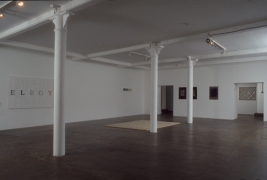Chora
An exhibition of 12 artists at the Underwood Street, Gallery, London (1999), touring to Hotbath Gallery, Bath (2000), South Hill Park, Bracknell (2000) and Abbott Hall, Kendall. (2000)
Sue Hubbard artist commentary from the exhibition ‘chora’
Published by chora, © Sue Hubbard, Simon Morley and the artists. 1999, London. ISBN 0 9536924 0 1
Edward Chell
But listen to the voice of the wind
And the ceaseless message that forms itself out of silence.
Rainer Maria Rilke (trans. Stephen Mitchell)
Edward Chell’s painting, filled with scrapped, erased and degraded marks, becomes a physical metaphor for transformation, for change, for the desire to express that which cannot be expressed. His subtle signs take on the appearance of text, a disrupted poetic syntax or musical notation from some ancient manuscript or folio of plain song. These delicate images stutter, like Demosthenes, into disrupted speech, into partial signs and meanings. Whilst they appear to parallel the deconstruction of language, they in fact suggest what Luce Irigaray describes as a ‘feminine’ difference from masculine models of subjectivity; a difference fundamental to thinking in what Luce Irigaray calls ‘the void’.
The underpinning of Chell’s work is in fact references to imaging technology and photography, specifically the relationship between digital and analogue modes. Digital imaging technology codifies information into sets of binaries such as numerical values. These will replicate as a constant without degradation. Analogue information, on the other hand, degrades in reproduction. This allows for change, evolution and metamorphosis and is, therefore, comparable not only to the process of making art, but also to life itself. This image of evolution stands in opposition to the stasis of death, which unlike the transmutations of life is ‘set in stone’. For Chell, this is comparable to the way in which Saussure and Derrida speak of grammar as fixed, while speech or slang is seen as mutable and evolving.
In this sense, then, Chell’s painting engages with notions of reproduction and originality, and his working methods – through which he imposes on himself various limitation – embody and on-going meditation of the relationship between mechanical reproduction and the act of making a unique painting. His images derive from photographs he has taken which have then been photocopied. The degrading of the image continues through the activity of painting in oils from these photocopies. For the series from which the work in CHORA comes, Chell has used a single image from an earlier series, limited himself to a set of five colours – titanium white, zinc white, ultramarine, burnt umber and Indian yellow – and then proceeded to create the ‘same’ work again and again, each one being a variation – a degradation – of the other. It is as though through these changes, something might be revealed, some potential space or state presented.
